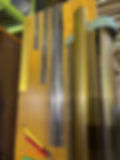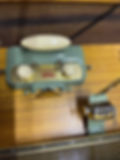The very unique Turmix Unic
- Maggi Bloice
- Jun 14
- 3 min read
Updated: Jul 29
The very unique Turmix Unic

This is a serious one off machine, never seen anything like it but I guess that’s why vintage knitting machines, especially single beds fascinate me so much.
On my initial post re this machine, I wrote about the way it was delivered and how it was in pristine condition, and this is true, however taking a more indepth look I realised now perhaps why it was not used. In the centre of the bed there is a faulty needle channel, possible because some poor soul had attempted to change the needle and damaged the channel looking for the tiny spring with a seriously pointed tool. Anyway my remit is to see how these old machines work and give an idea to anyone who has bought one just how useful they are as a main knitting machine. I just do it for fun, so I rarely knit a garment on these machines keeping my later electronics for that purpose.
As I said this is a very unusual machine built in Switzerland and it is a five mm gauge machine - however it struggles or even refuses to knit with anything thicker than 3 ply yarn.

To start, it is so easy to set up and it is so attractive with its soft gold finish. It is a plastic type of material bed and offers 160 needles and the same number of pins that act as sinker posts and ribber pins – each pin has a hollowed out bit so that you can slide stitches over the pins when knitting ribs or I suppose fancy stitches.
The tension mast which I slated on the initial post is not as I thought, it has an again unusual threading procedure and hidden between the 2 tension disks is a hole where you thread the yarn though, missed that one completely.
The pins are set on a post that straddles the whole bed and to move it you have to press a very strong spring that lowers it away from the bed, again I had fun with this, I could not for the life of me understand why it would not drop down until I discovered it needed sliding to a position where it was not stopped lowering by the ends of the bed, oh well such is life - what an idiot I am…

The casting on is via a cast on comb and to do this you keep the wire in the comb and lift the pins to their highest position and this for single bed cast on creates a kind of V with the yarn between the beds, you then lower the comb and place the weights. The next move is to lower the pins to the mid position and slip the stitches held off so the comb goes down, this is a weight driven machine.
Stocking stitch is fairly easy, you simply knit back and forth and the pins or sinker posts of an ilk, knit the stitches off, you must have these pins in working position.
Ribbing, so I simply transferred the stitches to the one by one pins that had been set in the highest position and do not forget to lower the empty needles (speaking from experience here). Ribbing is achieved by simply moving the carriage or slide as they call it, across the bed and you then use a tool or the comb provided for wider pieces to move the stitches from the bottom of the pins and over hence knitting another row, you follow this procedure onward.

What can I say, I provide a picture of the springs that hold the needles in place and what a hassle trying to get them out of the channel when having to change a needle. I need to try and get another bed for this machine as I need spare needles and the springs and perhaps another bed may not have a faulty channel.
Not a machine for the faint hearted and certainly if you are a beginner, then look for a good old Knitmaster punchcard or a Brother if you are buying to produce.
I have attempted to video a couple of bits for this machine for the first time, and I know I am nowhere near a good as a couple of lads I could mention who in my opinion produce fabulous clear videos but perhaps I will get better at it and who knows, I have some fabulous vintage machines that seriously need highlighting
Bear in mind I have a very slow wifi connection so downloading takes forever. Oops for got to show my massive sample piece!































































































